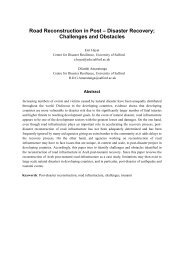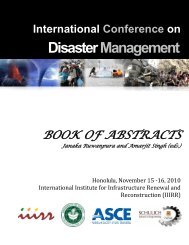Alternative resilient livelihood option for fisher-folks tsunami victims
Alternative resilient livelihood option for fisher-folks tsunami victims
Alternative resilient livelihood option for fisher-folks tsunami victims
Create successful ePaper yourself
Turn your PDF publications into a flip-book with our unique Google optimized e-Paper software.
1. Introduction<br />
Livelihoods in coastal areas totally depend on lagoon, coastal, offshore and deep sea fishing. Over<br />
the years, there has been a steady increase <strong>for</strong> the demand <strong>for</strong> fish protein in the developing country.<br />
Sri Lanka is already on the road to maximize aqua-exploitation along with the gold rush started<br />
back in 1990s. There is a need <strong>for</strong> development of an eco-friendly aquaculture industry is urgently<br />
needed. Unlike other intensive aquaculture ventures seaweed farming, crab fattening and milk fish<br />
farming in cages would be not only a good source of protein, nutrients <strong>for</strong> human diets and an<br />
alternative to the depletion of fish from the sea and thus pave a way to ameliorate an environmental<br />
pressure, but also a source of income <strong>for</strong> <strong>fisher</strong> <strong>folks</strong>.<br />
The national knowledge on seaweed farming in Sri Lanka is limited. There this farming carried out<br />
only small scale as community based seaweed farming. Seaweed farming could be a source of<br />
alternative income <strong>for</strong> <strong>fisher</strong>men to that of fishing. The culture period can last <strong>for</strong> 45 days and it is<br />
an environmental friendly farming method (Jayasuriya, 1987). Seaweeds <strong>for</strong> direct human<br />
consumption are worth more than those destined <strong>for</strong> industrial use. Culturing of the mud crab Scylla<br />
serrata is not economical and hence the crab fattening is practiced. The watery crabs at post-molt<br />
stage are fetching very low prices in the market and are even rejected in the export market because<br />
of their poor meat content. If fattened, they fetch a high price. In order to improve the living<br />
conditions of <strong>fisher</strong> folk and to reduce the pressure in the coastal marine ecosystem, alternative<br />
<strong>livelihood</strong> schemes were introduced to empower the village community especially <strong>for</strong> the women to<br />
earn extra income in their own and to help his her family to enhance their socio-economic status.<br />
Crab fattening is much more profitable than any other coastal aquaculture operations currently in<br />
practice (Sathiadhas & Najmudeen, 1991).The Crab fattening programme is one of such schemes<br />
initiated by the CIDA Restore Project in the Palameenmadu village with support from the<br />
Department of Fisheries, Batticaloa.<br />
The Mangrove ecosystem caters several environmental and economical functions to the surrounding<br />
peoples directly and indirectly. Supporting rich biodiversity, preventing coastal erosion, sea surge<br />
mitigation, facilitating of fish and shellfish spawning are some environmental functions of<br />
mangroves (Santharooban and Vinobaba, 2008). Though the mangroves support the community in<br />
several ways in Batticaloa district, but it is being continuously destroyed by human anthropogenic<br />
effects and other causes. Brackish water aquaculture was initiated very recently as an experimental<br />
venture with a view to its promotion. Milkfish (Chanos chanos) is an important food fish. The<br />
success of milkfish as a cultured food fish species may be attributed to its ability to tolerate<br />
extremes of environmental conditions. These conditions include extremes of temperatures, salinity,<br />
dissolved oxygen, ammonia, nitrite, crowding and starvation (Duenas, 1983). Their adaptability to<br />
these factors has allowed milkfish culturists to exploit the species by manipulating culture<br />
conditions.

















